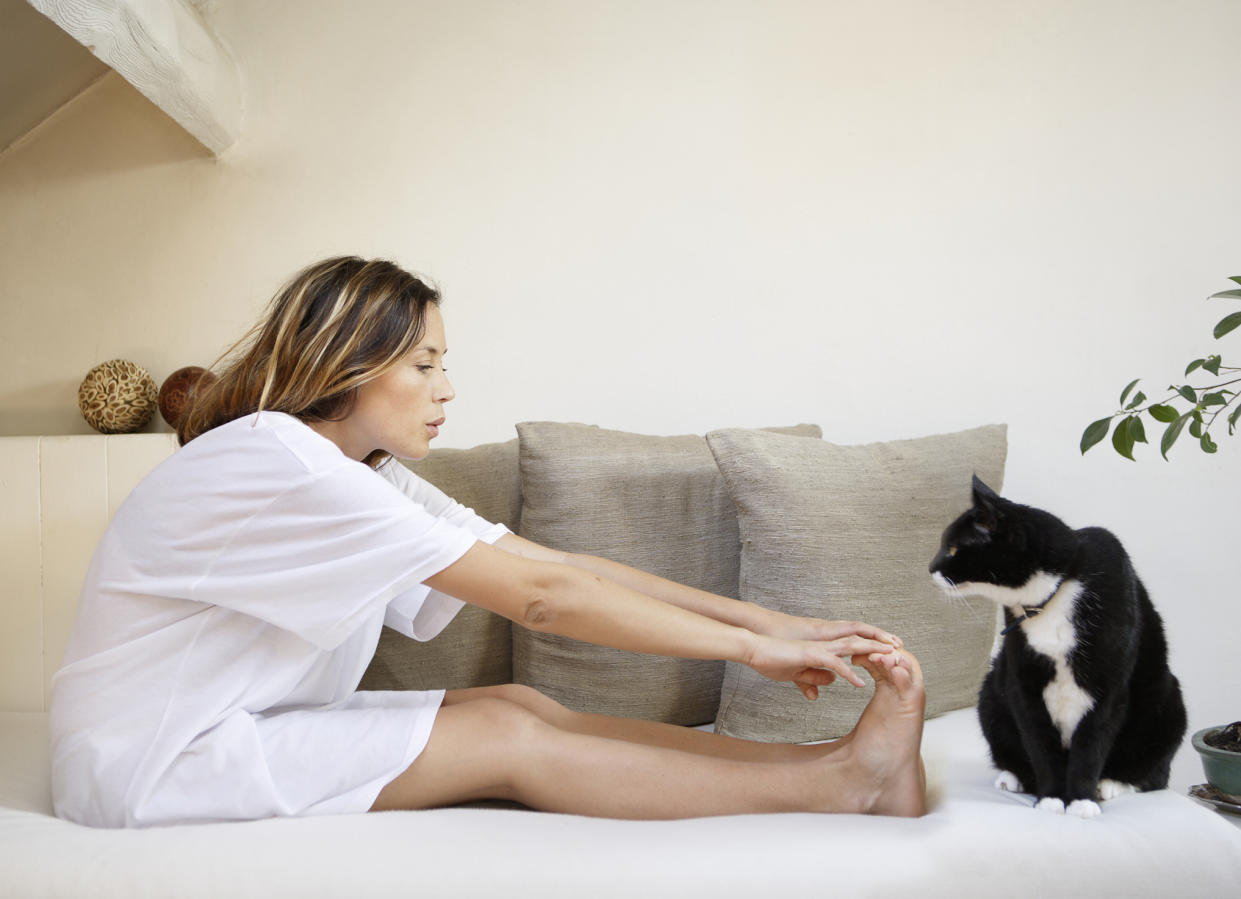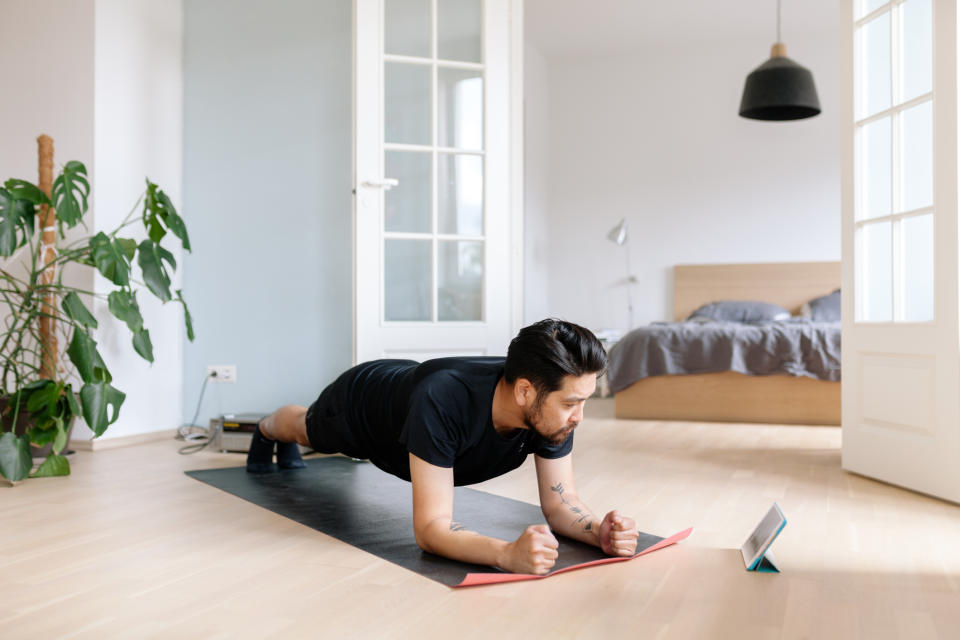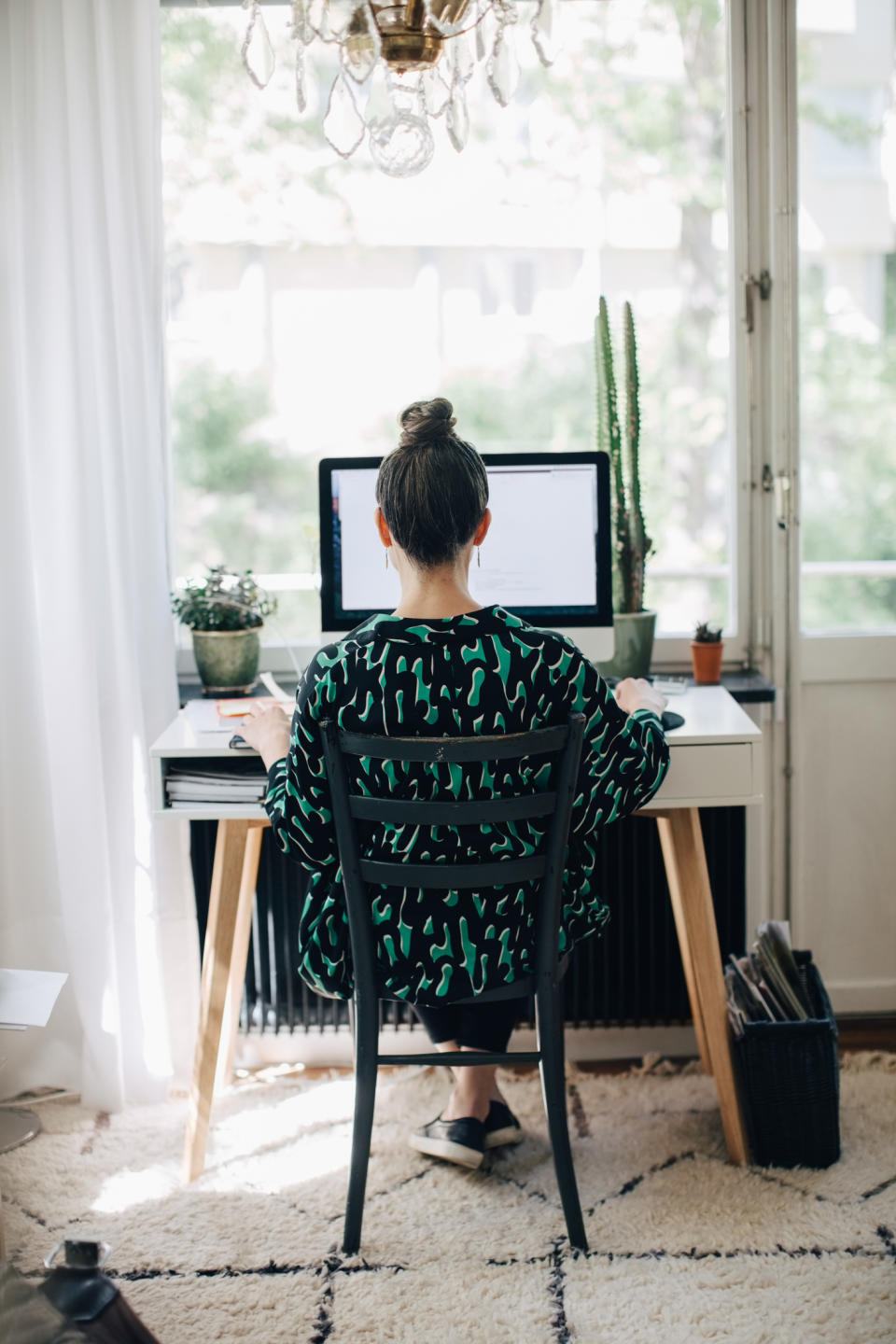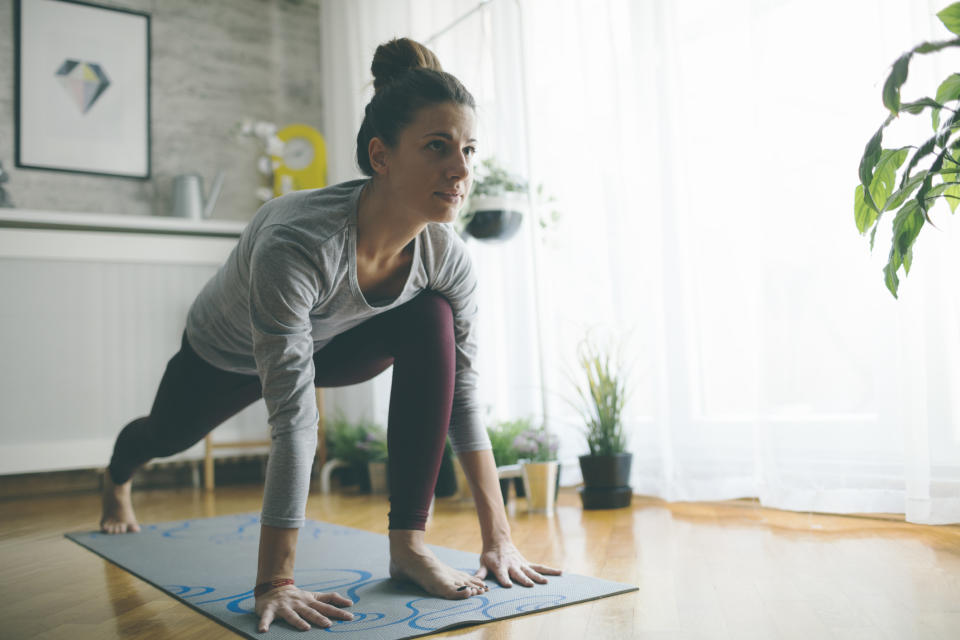Coronavirus: How to stay fit and healthy while self-isolating or working from home

As fears about the spread of coronavirus continue to rise, it is looking increasingly likely that life as we know it is about to be pretty severely disrupted.
Whether you’re already working from home, self-isolating or fear you may be in the future, despite PM Boris Johnson not yet giving the nod for a full UK lockdown, many are already resigning themselves to spending more time at home in the coming weeks.
But aside from an initial joy at being able to spend all day in our PJs, this spike in home-time could have some pretty big impacts on our health and fitness goals.
While gym-goers may have already begun to think twice about sharing equipment, changing rooms, and towels during the virus outbreak, those who have opted to self-avoid public transport could also see their usual fitness routines disrupted.
And sitting at our desks (or kitchen tables!) all day can have an impact on how much, or little, we’re moving.
Latest coronavirus news, updates and advice
Live: Follow all the latest updates from the UK and around the world
Fact-checker: The number of Covid-19 cases in your local area
Explained: Symptoms, latest advice and how it compares to the flu
- Do something healthy. If you can, get outside, enjoy fresh air, take a walk or bike ride with family & friends.
- If you can’t go outside, you might try yoga or tai chi inside your home.— Tedros Adhanom Ghebreyesus (@DrTedros) March 7, 2020
But keeping your body fit and healthy is even more important when there’s a global pandemic on the spread, as the Director General of the World Health Organisation (WHO) recently indicated on social media when he dished out some stay-fit-at-home advice.
“It's been a very busy week for everyone,” Dr Tedros Adhanom Gehebreyesus wrote on Twitter. “The world is fighting #COVID19 together as one. And yet life must go on. I hope everyone is taking rest this weekend.”
He went on to give some recommendations from the WHO including doing something healthy, like going outside for a walk or a bike ride.
If you’re not able to go outside, perhaps because you’re self-isolating, he suggested trying yoga or tai chi inside your home.

Why it is so important to stay active when stuck at home
The fact is that even though we could be spending more time at home, that’s no reason to let our health and fitness goals slide completely.
According to Dr Thomas Falda, Training Specialist at Freeletics being sedentary for long periods of time has some pretty serious physical health risks such as slower metabolism, muscle weakness, obesity and raised cholesterol levels.
“By keeping your muscles active your body will pump more blood around your body, and thus oxygen and nutrients that your body needs to stay healthy,” he explains.
“Our bodies are designed to move and designed to adapt to the situations they encounter. So, if you stop using any component of your body, you will lose them slowly. e.g. you'll slightly lose strength if your body never encounter situations where one has to apply a strong force; you'll slowly lose flexibility if your muscles are never stretched very far; and you'll slowly lose some cardio-pulmonary capacity if you are never out of breath.”
Not only that, but keeping active can help to limit the loneliness and negative mental health impacts of being isolated for long periods.
“If your body is no longer as moving as much as it was before in the short term sitting down all day may make you depressed due to the sheer boredom it causes,” explains Dr Falda.
There is also a biological reason for it too.
“Reduced movement means less blood flow and less blood flow means fewer feel-good hormones are moving through your body, helping you keep depression at bay.”
Common health guidelines usually recommend three activities per week that stimulate our cardio-pulmonary system, and about two activities per week that stimulates all our major muscle groups.
“As a general goal, we should aim for at least 30 minutes of moderate physical activity every day. However, if you can't fit in one 30-minute workout in the day, try a burst of a five-minute exercises instead,” Dr Falda suggests.
Yahoo UK spoke to the health and fitness experts on how you can stay on top of your health and fitness goals even if you’re quarantined.
Swap the gym for an online workout
“The days of exercise videos are long gone, YouTube now has a wealth of free home workout content, walking you through each exercise, as if you had your very own PT in your living room,” explains Nutrition & Fitness Expert for Natures Healthbox.
He suggests giving some HIIT workouts a try for a short, sharp fitness, er, hit.

Schedule your fitness time
By creating a workout plan for your week. “You might want to set certain exercises for certain days, or break your week out by body part,” says Jenane.
“By treating it like a gym, you will feel more motivated. You should also record progress and results, so you can be sure to increase the intensity on the next workout.”
Find a designated exercise area
Ok so not all of us will have a full gym in our spare room, but it is important to create some kind of ‘exercise area.’ “Put on some music on your laptop and clear the area so you don’t bump into anything,” suggests Jenane.
And if you have a garden then try working out there. Studies have shown that exercising outdoors has some amazing benefits for the body and mind.
Find a workout buddy
“If you’re forced to stay at home, but house-sharing with someone, then you can both push each other to set some time aside each day to workout together,” says Jenane. “This way each one of you can push the other to stay motivated.”
If you do have to sit all day, sit well
“I always say that sitting per se is not bad, it’s how we sit and how long we sit for that leads to health problems,” advises Pilates teacher Kerrie-Anne Bradley.
“Sitting well makes a big difference to your body, including helping to avoid desk-related back pain.” Bradley says there are some simple steps which can help ensure you are sitting in a way that keeps your body happy:
· Both feet should be flat on the floor. Toes pointing forward.
· Have a right angle at your ankle.
· Your knees should be pointing forward and tracking toes. Another right angle at the knee.
· Sit on your sit bones. The bones under your bum. Sitting on these should create another right angle where your legs meet your torso.
· Have your ribs over your hips.
· Make sure your shoulders are wide and away from the ears.
· Have your head in line with your spine (pop your hands behind your head and press your head into your hands, that'll get that head back).
Set a get-moving reminder
The temptation might be to move from your bed to your sofa and back again, but being sedentary for long periods can have some pretty big impacts on health and life expectancy.
“We can get in a tendency to stay seated, whether working on the laptop or watching TV, therefore you should set an alarm on your phone for every 45 minutes to get up and do something,” suggests Jenane.
“This could be as simple as making a coffee or walking around while calling a friend. This can also help to increase concentration when you return to your task.”
Bradley suggests getting up to move for three minutes every 30 mins.
Put on your gym kit
According to Dr Falda, simply putting on your gym gear can drastically change your motivation, mindset and mood.
“If you’re tempted to miss a workout put your gym clothes on first thing. If you look the part, there’s no reason not to exercise, even if it’s just for a little bit.
“Especially if you’re isolated at home there’s no reason why you can’t put on your gym gear first thing in the morning, as you know you will be able to exercise by the end of the day.”
Breathe yourself healthier
If finding time to exercise in these coronavirus-laced times is too tricky, try to focus on your breathing.
From helping to calm your nervous system, feel energised, stretch your back muscles and feel generally well, according to Bradley big breathing has so many benefits.
She suggests trying this big breathing exercise:
· Place your hands on your bottom ribs, thumbs on the back-bottom ribs.
· Inhale through your nose to a count of five sending your breath to the bottom ribs (your hands will move away from each other). Concentrate on breathing into your thumbs especially.
· Exhale to a count of five through your mouth. Thumbs return to their starting place.
· Do 10 big breaths a few times throughout the day.
Read more: Coronavirus: how to keep your mental health in check

Do some deskercise
Just because you're house-bound, it doesn't mean you have to let your fitness suffer, there are plenty of ways to stay fit at your make-shift desk (read kitchen table!).
Feel Good Contacts has teamed up with Personal Trainer and Fitness Expert Badrul Islam to help you workout while working from home.
Bottle dumbbell over-the-head press: Sitting on a chair, hold a bottle of water laterally in each hand, with your hands next to each ear. Press above the crown of your head, making sure your upper arm finishes by the side of your head.
Bottle dumbbell skull-crushers: Laying on the floor with knees up, holding a bottle of water in each hand, extend your arms over your chest, keeping your arms straight, tilt your arms 20 degrees so your hands are over your face. Bend your elbows so your hands come towards your shoulder but do not allow your shoulder to move. Then extend your arm back to the start position, maintaining no movement in the shoulder.
Bottle dumbbell curls: Holding a bottle in each hand, have each arm extended to the side of your torso. Keeping your elbows tucked into your ribs, flex elbows in until hands almost align with your shoulders. Then slowly extend.
Reverse flyes: Resting your forehead on the back of your chair with bent knees, maintaining a neutral spine so that your torso is almost parallel with the floor. Hang your arms below your chest with a slight bend in your elbow. Pull your arms and hands out laterally so they end up horizontal to the floor and lower them slowly back to the start position.
Standing calf raises: Standing with your feet shoulder-width apart and toes pointed forwards, raise yourself up onto your toes, then lower yourself down. Repeat 20 times.
Push-ups on your desk: Placing your hands on the edge of your desk, bend your elbows to lower your chest towards the desk, then push off your hands to raise yourself back up.
Tricep dips on your desk: Facing away from your desk, place your hands on the edge and bend your elbows to lower your body whilst simultaneously bending your knees. Then push yourself up again.
Knee tucks: Sit at the edge of your chair and hold onto the arm of the chair. Bring your knees and ankles together and raise your knees.
Squats: Stand with your feet about shoulder-width apart and bring your hips back to lower yourself. Keep your chest up for maximum effectiveness and make sure you push through your heels to raise yourself back up.



